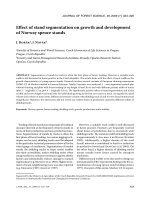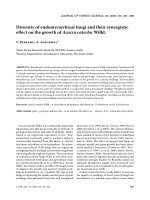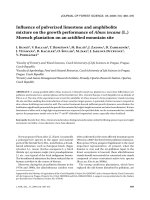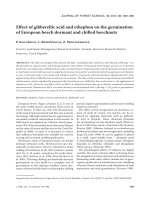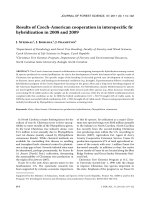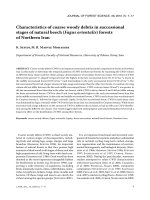Báo cáo lâm nghiệp: "Effect of site quality and thinning management on the structure of holm oak forests in northeast Spain" pot
Bạn đang xem bản rút gọn của tài liệu. Xem và tải ngay bản đầy đủ của tài liệu tại đây (1.13 MB, 14 trang )
Original
article
Effect
of
site
quality
and
thinning
management
on
the
structure
of
holm
oak
forests
in
northeast
Spain
M
Gracia
J
Retana
1
Centre
de
Recerca
Ecològica
i Aplicacions
Forestals,
Facultat
de
Ciències,
Universitat Autònoma
de Barcelona,
08193
Bellaterra,
Barcelona;
2
Departament
de
Producciò
Vegetal
i
Ciència
Forestal,
Universitat
de
Lleida,
Rovira
Roure
177,
25006
Lleida,
Spain
(Received
6
September
1994;
accepted
20
November
1994)
Summary —
In
the
holm oak
forests
of
NE
Spain,
the
variability
of
thinning
intensity,
together
with
the
great
heterogeneity
of
site
quality,
due
to
the
rough
topography
of
the
region,
gives
rise
to
important
struc-
tural
differences
among
stands.
In
this
paper,
we
analyze
the
effect
of
site
quality
and
thinning
man-
agement
on
the
structural
heterogeneity
of
holm
oak
stands
at
the
end
of
the
cutting
cycle
in
different
areas
of
the
Montseny
and
Les
Guilleries
massifs
(NE
Spain).
These
two
factors
influence
the
main
struc-
tural
variables
of
the
stands
in
various
ways.
Height
was
used
as
an
indicator
of
site
quality,
because
it
was
relatively
unaffected
by
thinning
management,
while
density
and
total
number
of
stems
per
stool
were
strongly
affected.
Mean
tree
diameter
reflected
the
effect
of
both
site
quality
and
thinning.
The
type
of
forest
management
was
found
to
be
the
most
important
factor
determining
forest
structure.
Site
quality
was
a
constraint
of
stand
development,
contributing
in
poor
stands,
to
increased
differences
due
to
thinning
management.
holm
oak
/ Ouercus
ilex / forest
structure
/ site
quality
/ thinning
Résumé —
Effets
de
la
fertilité
de
la
station
et
de
l’intensité
d’éclaircie
sur
la
structure
des
forêts
de
chêne
vert
du
nord-est
de
l’Espagne.
Dans
les
forêts
de
chêne
vert
du
nord-est
de
l’Es-
pagne,
la
variabilité
de
l’intensité
d’éclaircie
et
la
grande
hétérogénéité
de
fertilité
des
stations,
dues
à
leur
topographie
montagneuse,
provoquent
d’importantes
différences
de
structure
des
peuplements.
Dans
cet
article,
nous
analysons
l’effet
de
la
fertilité
de
la
station
et
de
la
gestion
sylvicole
sur
l’hété-
rogénéité
structurelle
des
forêts
de
chêne
vert
dans
différentes
zones
des
massifs
de
Montseny
et
les
Guilleries
(nord-est
de
l’Espagne).
Ces
deux
facteurs
influencent
de
différentes
manières
les
principales
variables
descriptives
de
la
structure
des
peuplements.
La
hauteur
a
été
utilisée
comme
indice
de
fertilité
de
station
car
elle
est
très
peu
modifiée
par
le
type
de
gestion
sylvicole,
tandis
que
la
densité
et
le
nombre
total
de
brins
par
souche
sont
très
affectés
par
le
type
de
gestion.
La
diamètre
moyen
syn-
thétise
l’effet
de
la
fertilité
de
la
station
et
de
l’intensité
d’éclaircie.
La
gestion
sylvicole
est
le
facteur
le
plus
important
pour
expliquer
les
différences
de
structure
de
peuplement,
tandis
que
la
fertilité
de
la
sta-
tion
peut
être
un
facteur
limitant
du
développement
des
peuplements,
contribuant,
dans
les
stations
de
moindre
qualité,
à
augmenter
les
différences
dues
à
la
gestion
sylvicole.
chêne
vert / Quercus
ilex
/ structure
de
la
forét / fertilité
de
la
station / éclaircie
INTRODUCTION
Heterogeneity
is
an
intrinsic
feature
of
the
Mediterranean
landscape
(Naveh
and
Lieberman,
1984;
Barbero,
1988).
This
het-
erogeneity
appears
not
only
in
the
variation
of
species
composition
associated
with
gra-
dients
of
aspect,
elevation
or
soil
depth
(Aschmann,
1973;
Rabinovitch-Vin,
1983;
Quezel
and
Barbero,
1989;
Pigott
and
Pig-
ott,
1993),
but
also
in
the
changes
of
stand
structure
and
architecture
of
trees
observed
within
the
same
stand.
It
is
therefore
nec-
essary
to
carry
out
a
description
of
these
forests
based
on
structural,
architectural
and
physiognomic
features
on
the
different
vertical
strata
of
the
canopy,
that
provide
information
about
this
dynamic
environment,
which
is
a
habitat
of
animal
communities
(Cody,
1985;
De
Garnica
and
Robles,
1991),
liable
to
suffer
disturbances
(Sousa,
1984;
Lorimer,
1989;
Oliver
and
Larson,
1990),
and
potentially
be
used
and
exploited
in
numerous
ways
(Ducrey,
1992).
Holm
oak
(Quercus
ilex)
coppice
forests
are
one
of
the
most
representative
com-
munities
in
the
western
part
of
the
Mediter-
ranean
basin
(they
cover
more
than
120
000
ha
in
Catalonia
alone;
Montoya,
1988).
In
this
type
of
forest,
the
inherent
heterogeneity
of
Mediterranean
ecosystems
has
multiple
origins
that
overlap
on
different
temporal
and
spatial
scales
(David
et
al,
1979;
Floret
et
al,
1989;
Barbero,
1988;
Romane
et
al,
1988).
In
addition
to
this
environmental
het-
erogeneity,
there
is
one
another
caused
by
human
influence,
as
this
type
of
forest
ecosystem
has
been
subjected
for
decades
or
even
centuries
to
frequent
coppicing
(Di
Castri,
1973;
Terradas,
1991;
Barbero
et
al,
1992).
In
this
study
we
analyze
the
effect
of
site
quality
and
thinning
management
on
the
structural
heterogeneity
of
holm
oak
forests
at
the
end
of
the
cutting
cycle.
The
initial
response
of
holm
oak
forests
to
different
thinning,
fertilization
and
irrigation
practices
has
been
previously
studied
by
measuring
parameters
such
as
growth
of
remaining
trees,
production
and
dynamics
of
sprouts,
etc
(Cartan-Son
et
al,
1992;
Ducrey,
1992;
Ducrey
and
Turrel,
1992;
Floret
et
al,
1992;
Mayor
and
Rodá,
1994).
Nevertheless,
these
studies
are
relatively
recent,
and
it
has
not
yet
been
possible
to
evaluate
the
relative
importance
of
these
factors
in
the
structural
features
of
the
stands
in
the
medium
term.
STUDY
AREA
AND
METHODS
This
study
was
carried
out
in
three
different
areas:
Gualba,
in
the
southwestern
sector
of
the
Montseny
Massif
(40
km
from
Barcelona,
Spain),
Arbúcies,
in
the
northern
sector
of
the
Montseny
Massif
(90
km
from
Barcelona),
and
Susqueda,
in
the
southwestern
sector
of
the
Les
Guilleries
Mas-
sif
(110
km
from
Barcelona).
The
climate
of
the
region
is
subhumid
Mediterranean.
Mean
annual
precipitations
range
from
600
to
800
mm
and
mean
annual
temperatures
from
10
to
15 °C.
Soils
are
developed
on
a
bedrock
of
granite
and
metamorphic
schists.
The
main
vegetation
type
of
the
area
corresponds
to
the
montane
holm-oak
forest
(Quercetum
mediterraneo-montanum),
with
Q
ilex
as
the
main
component
at
the
tree
layer,
and
Erica
arborea
and
Arbutus
unedo
as
the
main
components
of
the
shrub
layer.
Holm
oak
forests
of
this
region
are
managed
by
coppicing
through
selective
cutting
at
intervals
of
approximately
30
years
(Retana
et
al,
1992).
Together
with
this
variability
in
management
practices,
there
is
a
spatial
heterogeneity
in
site
quality
due
to
the
rough
topography
of
the
region.
To
distinguish
between
the
effects
of
management
and
quality,
plots
which
differed
in
only
one
of
these
two
fac-
tors
have
been
compared.
In
each
area,
two
adjacent
stands
with
differ-
ent
thinning
management
were
chosen:
one
qual-
ified
as
’conservative
thinning’,
and
another
as
’intense
thinning’.
In
the
area
of
Susqueda,
a
third
stand,
referred
to
as
’old
forest’
was
also
included.
The
three
stands
corresponding
to
conservative
thinning
belonged
to
the
same
owner,
and
were
managed
by
selective
thinning.
This
practice
involved
a
period
of
about
25-30
years
between
harvests,
a
variable
harvest
of
basal
area
(40-60%),
and
special
care
in
the
selection
of
the
remaining
trees.
These
stands
had
a
similar
age
from
last
thinning.
The
three
stands
corre-
sponding
to
intense
thinning
were
all
character-
ized
by
a
less
careful
management.
The
high
cut-
ting
intensities
of
these
stands
had
the
characteristics
of
clear
felling
practice
in
some
cases.
They
presented
a
longer
period
between
harvests
than
stands
which
were
thinned
con-
servatively.
The
stand
of
old forest
in
Susqueda
was
a
portion
of
the
conservatively
thinned
stand
that
was
not
cut
in
the
last
thinning
period.
There-
fore,
its
age
from
last
thinning
was
70
years
instead
of
35.
In
each
stand,
and
within
the
limits
of
the
same
slope,
several
plots
which
seemed
to
be
repre-
sentative
of
the
best
and
the
worst
qualities
were
chosen.
The
selection
of
plots
was
based
on
an
assessment
of
the
general
aspect
of
the
plot
and
the
size
and
physiognomy
of
holm
oaks.
Table
I
summarizes
the
main
features
of
the
different
plots
considered
in
the
present
study.
To
evaluate
the
effect
of
site
quality
on
forest
structure,
plots
of
different
stands
with
the
same
thinning
man-
agement
(including
criteria of
stem
selection,
intensity
and
age
from
last
thinning),
have
been
compared.
To
evaluate
the
effect of
thinning
man-
agement,
plots
of
different
stands
of
the
same
area
with
similar
quality
were
compared.
Domi-
nant
height
has
been
chosen
as
site
index,
based
on
data
obtained
in
a
previous
study
(Gracia,
in
preparation),
because
it
attains
several
objec-
tives:
1)
it
shows
significant
relationships
with
site
variables;
2)
it
is
the
structural
variable
that
is
most
closely
correlated
with
other
structural
vari-
ables,
especially
mean
diameter,
when
man-
agement
is
constant;
and
3)
it
stabilizes
very
quickly
after
thinning,
and
is
not
affected
by
thin-
ning
intensity.
In
each
of
the
tree
areas,
groups
of
plots
of
similar
site
quality
(plots
which
did
not
show
significant
differences
in
height
from
an
analysis
of
variance)
have
been
established.
A
group
of
low
quality
plots
and
another
of
high
quality
plots
have
been
distinguished
in
each
area.
Circular
plots
with
a
12
m
radius
(450
m2)
were
established.
In
each
plot,
the
following
measures
were
taken:
—
topographic
factors:
elevation,
aspect,
slope
and
position
on
the
slope
(low,
medium
and
high)
—
diameter
at
breast
height
(dbh)
of
all
standing
trees
larger
than
5
cm
dbh
—
height
of
the
ten
tallest
trees
in
the
plot
Forest
structure
has
been
described
using
the
following
variables:
—
density
of
stems
above
5
cm
dbh
—
basal
area
—
mean
dbh
of
stems
above
5
cm
dbh
—
dominant
height
—
number
of
stems
per
stool
—
stool
equivalent
diameter,
which
is
the
diameter
that
has
the
same
basal
area as
the
sum
of
the
basal
areas
of
all
stems
from
the
stool.
To
elaborate
on
the
diameter
distributions,
stems
of
each
plot
were
grouped
in
width
intervals
of
2.5
cm,
starting
from
the
initial
lowest
value
of
5
cm
dbh.
Diameter
distributions
have
been
com-
pared
by
means
of
the
Kolmogorov-Smirnov
test.
RESULTS
Overall
analysis
of
the
three
stands
of
conservative
thinning
In
order
to
analyze
features
in
stands
with
similar
thinning
management,
the
nine
plots
of
the
three
stands
with
conservative
thin-
ning
have
been
considered
together.
Mean
values
of
structural
features
for
these
plots
are
summarized
in
table
II.
Differences
among
plots
were
significant
for
all
struc-
tural
variables
(F-test,
P
< 0.0001),
although
the
Fisher
LSD
multiple-comparison
proce-
dure
(Ott,
1988)
showed
different
trends:
a)
mean
height
of
different
plots
had
a
gradient,
which
makes
it
impos-
sible
to
define
independent
groups,
except
for
the
one
composed
by
plot
cA4,
of
high-
est
quality;
b)
three
different
groups
of
plots
were
identified
according
to
mean
diame-
ter;
once
again
the
cA4
plot
formed
an
inde-
pendent
group
of
exceptionally
large
mean
diameter;
c)
the
results
concerning
the
num-
ber
of
stems
per
stool
were
even
more
sim-
plified,
because
only
two
independent
groups
of
plots
could
be
identified:
those
with
a
large
number
of
stems
per
stool,
which
also
had
the
smallest
mean
diame-
ters
and
mean
heights,
and
those
with
a
small
number
of
stems
per
stool,
which
also
had
the
largest
mean
diameters
and
mean
heights;
and
d)
it
was
not
possible
to
identify
different
groups
for
the
stool
equivalent
diameter
because
the
values
of
different
plots
were
quite
similar,
excepting
those
of
the
plots
of
highest
quality
(cA4,
cG3).
A
correlation
analysis
between
the
main
structural
variables
of
the
nine
plots
with
conservative
thinning
has
been
carried
out
(table
III).
Height
was
correlated
with
most
other
variable,
especially
with
the
mean
diameter
(r =
0.98),
but
also
with
the
total
density
of
stems
(r
=
-0.89)
and
the
stool
equivalent
diameter
(r =
0.88).
The
rela-
tionship
between
height
and
the
number
of
stems
per
stool
was
lower
(r=-0.62),
while
the
relationship
with
basal
area
was
not
sig-
nificant.
The
mean
diameter
also
displayed
accurate
correlation
coefficients
with
the
other
variables,
even
with
basal
area,
which
was
not
significantly
correlated
with
the other
structural
variables
in
this
analysis.
Comparison
of
different
stands
within
the
same
area
In
each
of
the
groups
of
plots
with
similar
site
quality,
we
have
compared
the
differ-
ent
variables
considered.
In
the
areas
of
Arbúcies
(table
IV)
and
Gualba
(table
V),
the
plots
of
stands
managed
by
conservative
thinning
and
those
managed
by
intense
thin-
ning
were
clearly
distinguished
in
both
low
and
high
quality
sites.
Plots
from
stands
under
intense
thinning
had
smaller
mean
diameters
and
a
greater
number
of
stems
per
stool
than
plots
from
stands
under
by
conservative
thinning.
In
the
area
of
Susqueda
(table
VI),
plots
of
similar
qual-
ity
did
not
show
significant
differences
in
mean
diameter,
and
only
differed
in
the
mean
number
of
stems
per
stool
between
the
stand
of
intense
thinning
and
the
stands
of
conservative
thinning
and
old
forest.
The
stool
equivalent
diameter,
in
general,
did
not
vary
in
plots
of
similar
quality
and
dif-
ferent
type
of
management,
excepting
those
of
high
quality
in
Gualba
and
Susqueda
(tables
IV
and
VI).
Relationship
among
the
structural
variables
considered
Another
correlation
analysis
has
been
car-
ried
out
with
all
plots
of
different
thinning
intensity (table
VII).
In
general,
correlation
values
decreased
with
respect
to
those
obtained
with
only
the
plots
of
conservative
thinning
(table
III).
Height
maintained
good
correlations
with
the
stool
equivalent
diam-
eter
(r =
0.81)
and
the
mean
diameter
(r
=
0.76),
but
not
with
the
total
density
of
stems
or
the
number
of
stems
per
stool.
The
mean
diameter
was
the
variable
most
closely
cor-
related
with
the
other
structural
variables,
showing
similar
values
to
those
obtained
with
only
the
plots
under
conservative
thin-
ning
(table
III).
Basal
area
alone
presented
a
significant,
but
low,
correlation
with
height
(r= 0.47).
Diameter
distribution
in
the
different
plots
Within
the
same
stand,
the
low
quality
plots
displayed
a
greater
number
of
small
stems
than
the
high
quality
plots.
The
shape
of
the
distribution
changed
severely.
The
differ-
ences
between
the
extreme
situations
were
significant
in
all
stands
(Kolmogorov-
Smirnov test,
P
< 0.10).
This
trend
is
shown
in
figure
1,
where
the
diameter
distributions
of
the
four
plots
of
stand
cA
are
in
ascend-
ing
order
from
cA1
to
cA4.
comparison
of
plots
of
similar
site
quality
and
different
management
showed
several
differences:
a)
in
high
quality
plots
(fig
2),
differences
due
to
management
were
only
significant
in
the
area
of
Gualba
(Kol-
mogorov-Smirnov
test,
P
<
0.05),
but
not
in
the other
two
areas
(Kolmogorov-Smirnov
test,
P
> 0.10);
and
b)
in
low
quality
plots,
there
were
significant
differences
among
plots
of
the
two
areas
due
to
management
(fig
3)
(Kolmogorov-Smirnov
test,
P
< 0.05):
conservative
management
led
to
an
almost
normal
distribution,
while
intense
manage-
ment
led
to
a
unimodel
distribution.
The
effect
of
thinning
even
reversed
the
usual
trend
of
a
decreasing
number
of
small
stems
with
increasing
site
quality: plot
cS2
pre-
sented
a
distribution
closer
to
normal
than
the
higher
quality
plot
iS2
(fig
3).
Diameter
distributions
in
plots
under
conservative
thin-
ning
and
old
thinning
of
Susqueda
(fig
4)
were
not
significantly
different
(Kol-
mogorov-Smirnov
test,
P > 0.10),
although
there
were
fewer
intermediate-sized
stems
in
the
more
recently
cut
plots.
DISCUSSION
Effect
of
site
quality
and
thinning
on
the
structural
variables
of
the
holm
and
stands
The
changes
in
site
quality
and
manage-
ment
have
different
effects
on
the
structural
variables
of
the
stands:
several
variables,
such
as
height,
can
be
considered
as
plot
characteristics
and,
within
certain
limits,
only
depending
on
site
quality
(Gracia,
in
prepa-
ration);
nevertheless,
the
majority
of
vari-
ables
are
more
or
less
affected
both
by
site
quality
and
by
management.
Density
is
related
to
site
quality,
as
can
be
deduced
from
the
correlation
obtained
between
the
plots
with
conservative
thinning.
This
result
agrees
with
the
one
given
by
Lledó
et
al
(1992)
for
a
holm
oak
forest
in
Prades
(Tar-
ragona),
where
the
differences
in
density
found
between
the
low
and
high
elevation
zones
of
the
same
slope
have
been
attributed
to
differences
in
productivity
(ie,
site
quality).
This
close
relationship
between
height
and
density
disappears
when
all
plots
are
taken
into
account,
because
of
the
over-
siding
effect
of
management
on
density.
A
high
thinning
intensity
would
lead
to
low
densities,
as
would
a
decrease
in
site
qual-
ity.
The
number
of
stems
per
stool
is
also
strongly
affected
by
management,
as
can
be
deduced
from
the
comparison
of
stands
within
the
same
area.
It
is
less
affected
by
site
quality
than
density
and
can
thus
be
considered
a
more
suitable
variable
for
dis-
criminating
between
different
thinning
man-
agements.
Data
obtained
in
this
study
(ie,
the
high
correlation
between
height
and
diameter
for
the
plots
with
conservative
thinning,
which
decreases
when
all
plots
of
different
man-
agement
are
considered)
support
the
strong
dependence
with
diameter
on
both
site
qual-
ity
and
managements
described
in
other
studies
(Cartan-Son
et
al,
1992;
Ducrey
and
Turrel,
1992;
Mayor
and
Rodá,
1993).
That
is
why
this
variable
is
probably
the
one
that
yields
the
most
information
about
forest
structure.
Nevertheless,
and
for
the
same
reason,
it
does
not
allow,
on
its
own,
an
analysis
of
the
role
played
by
different
fac-
tors
on
the
actual
forest
structure.
Nothing
has
been
said
about
basal
area,
one
of
the
most
important
variables
from
the
silvicultural
point
of
view
(Montero,
1992).
Although
basal
area
is
the
variable
most
closely
related
with
forest
biomass
(Bengoa,
1993),
its
extrapolation
to
pro-
ductivity
is
quite
difficult,
because
it
would
be
necessary
to
include
a
time
factor
and
to
know,
for
selective
thinning,
the
amount
of
timber
harvested.
In
the
studied
plots,
basal
area
was
a
very
unpredictable
variable,
which
only
showed
a
slight
tendency
to
increase
with
site
quality.
Site
quality
and
thinning
management
as
factors
conditioning
the
structural
development
of
holm
oak
forest
Ducrey
(1992)
proposed
a
theoretical
cycle
of
development
of
holm
oak
forests,
with
a
coppice
stabilized
by
clear
felling
practices,
and
a
maturity
stage
that
would
be
reached
after
a
long
period
of
time
without
distur-
bances.
This
idea
of
a
structural
maturity
of
holm
oak
forests
is
also
used
by
other
authors
(Barbero,
1988;
Lledó
et
al,
1992),
and
could
be
defined
as
a
forest
formed
by
one-stemmed
stools
of
large
size,
with
low
density
and
a
tendency
towards
uniformity.
The
similarity
between
the
structural
fea-
tures
of
the
studied
plots
and
this
ideal,
mature
state
allows
us
to
discuss
the
role
of
site
quality
and
management
as
factors
slowing
down,
stabilizing
or
accelerating
the
developmental
process
of
holm
oak
forests.
When
other
factors
are
similar,
site
charac-
teristics
move
this
development
towards
mature
forest.
In
high
quality
plots,
forest
structure
is
similar
to
that
of
a
theoretically
mature
forest.
This
is
particularly
evident
in
the
old
thinning
stand.
Lledo
et
al
(1992)
also
observed
in
holm
oak
forests
in
Prades
(Tarragona)
that
high
quality
areas
show
a
greater
degree
of
maturity
than
low
quality
areas,
with
smaller
densities
and
greater
mean
diameters.
This
pattern
is
also
clearly
observed
in
the
diameter
distributions.
For
a
given
stand,
the
lower
quality plots
show
a
greater
num-
ber
of
small
diameter
stems
than
those
of
higher
quality.
Courraud
(1987)
explains
this
fact
by
considering
that
in
low
quality
sites
very
few
trees
attain
superiority
in
size
in
relation
to
their
neighbors
sufficient
to
exclude
them.
In
high
quality
sites,
there
is
a
decrease
in
individuals
in
the
smaller
classes,
with
a
tendency
to
normality
which
is
clearest
in
the
old
forest
stand
(oS).
Bar-
bero
(1988)
describes
this
pattern
in
monospecific
holm
oak
forests
with
com-
plete
cover
by
means
of
a
multistrata
struc-
tural
model,
characterized
by
having
sev-
eral
dominant
sprouts
per
stool
and
a
greater
number
of
suppressed
sprouts,
which,
in
high
quality
sites,
are
very
quickly
eliminated.
In
the
studied
plots,
managements
is
an
essential
factor
affecting
structural
devel-
opment.
The
old
plots
are
obviously
the
clos-
est
to
our
ideal
of
a
mature
forest
and
par-
ticularly
the
high
quality
plot
has
a
high
forest
physiognomy,
with
one-stemmed
stools,
a
monospecific
composition
in
the
overstory,
and
an
almost
completely
absent
under-
story.
The
stands
under
conservative
thin-
ning
show
values
of
the
structural
variables
similar
to
those
obtained
for
the
old
thinning
stand.
It
is
quite
surprising
how
quickly
the
holm
oak
forest
recovers
from
thinning,
which
suggests
that
this
type
of
manage-
ment
stabilizes
the
forest
in
a
state
very
similar
to
the
one
described
as
mature
for-
est.
In
contrast,
the
plots
exploited
by
intense
thinning
show
large
differences
com-
pared
with
the
mature
forest
model
with
respect
to
the
number
of
stems
per
stool,
density,
multispecific
composition
of
the
overstory
and
degree
of
development
of
the
understory.
The
results
obtained
suggest
that
both
site
quality
and
thinning
management
are
responsible
for
the
heterogeneity
of
the
stud-
ied
holm
oak
forests.
Given
the
range
of
variation
among
these
factors
in
the
region,
management
probably
has
a
larger
impor-
tance
in
this
heterogeneity.
Site
quality
either
favors
or
limits
forest
development,
as
sug-
gested
by
the
greater
differences
between
types
of
management
found
in
low
quality
plots
than
in
high
quality
plots.
In
extreme
sit-
uations
with
incomplete
cover,
we
could
find
what
Barbero
(1988)
defined
as
the
pro-
gressive
architectural
model,
characterized
by
stools
with
a
great
number
of
stems
which
coexist
from
the
subhorizontal
to
the
vertical
position.
However,
in
the
study
area,
this
pattern
is
only
found
in
very
disturbed
forests
or
in
very
rocky
areas.
The
results
presented
in
this
paper
suggest
the
role of
site
quality
and
thinning
management
on
the
structure
of
holm
oak
forests.
A
deeper
knowledge
of
these
topics
will
make
it
pos-
sible
to
provide
basic
information
for
a
more
coherent
forest
management
design.
ACKNOWLEDGMENTS
Thanks
are
due
to
E
Garolera
and
P
Tortadés
for
allowing
us
to
carry
out
this
study
on
their
properties,
and
to
T
Lokingbill
for
English
cor-
rection.
This
research
was
partly
funded
by
INIA
project
SC94-023.
REFERENCES
Aschmann
H
(1973)
Man’s
impact
on
the
several
regions
with
mediterranean
climates.
In:
Mediterranean-type
Ecosystems.
Origin
and
Structure
(F
Di
Castri,
HA
Mooney,
eds),
Springer-Verlag,
Berlin,
363-372
Barbero
M
(1988)
Caractérisation
de
quelques
struc-
tures
et
architectures
forestières
des
arbres
et
arbustes
à
feuilles
persistantes
de
l’étage
méditer-
ranéen.
Rev For Fr 40,
371-380
Barbero
M,
Loisel
R,
Quezel
P
(1992)
Biogeography,
ecology
and
history
of
Mediterranean
Quercus
ilex
ecosystems.
Vegetatio
99-100,
19-34
Bengoa
J
(1993)
Calidad
de
estación
en
rebollares
de
la
Rioja:
altemativas
al Indice
de
Sitio.
I Congreso
Fore-
stal
Español,
vol
II,
473-478
Cartan-Son
M,
Floret
C,
Galan
MJ
et
al
(1992)
Factors
affecting
radial
growth
of
Quercus
ilex
in
a
coppice
stand
in
southern
France.
Vegetatio
99-100,
61-68
Cody
ML
(1985)
An
introduction
to
habitat
selection
in
birds.
In:
Habitat
Selection
in
Birds
(ML
Cody,
ed),
Academic
Press,
London,
3-56
Courraud
R
(1987) Diagnostic
des
peuplements
de
chênes.
Forêt-Entreprise
45,
96-111
David
F,
Poissonet
P,
Romane
F
(1979)
Analyse
de
la
structure
horizontale
d’un
taillis
de Bouleaux
(Betula
verrucosa
Ehrh)
en
Sologne.
Acta
Oecol,
Oecol
Plant
14, 237-247
De
Garnica
R,
Robles
L
(1991)
Un
método
para
la
clasi-
ficiación
fisionómica
de
las
encinas
y
los
encinares.
Ecología
5, 173-180
Di
Castri
F
(1973)
Soil
animals
in
latitudinal
and
topo-
graphical
gradients
of
mediterranean
ecosystems.
In:
Mediterranean-type
Ecosystems.
Origin
and
Structure
(F
Di
Castri,
HA
Mooney,
eds),
Springer
Verlag,
Berlin,
171-190
Ducrey
M
(1992)
Quelle
sylviculture
et quel
avenir
pour
les
taillis
de
chêne
vert
(Quercus
ilex
L)
de
la
région
méditerranéenne.
Rev For Fr 44,
12-34
Ducrey
M,
Turrel
M
(1992)
Influence
of
cutting
methods
and
dates
on
stump
sprouting
in
holm oak
(Quer-
cus
ilex
L)
coppice.
Ann
Sci
For 49,
449-464
Floret
C,
Galan
MJ,
Le
Floc’h
E,
Rapp
M,
Romane
F
(1989) Organisation
de
la
structure,
de
la
biomasse
et
de
la
minéralomasse
d’un
taillis
ouvert
de
chêne
vert
(Quercus
ilex
L).
Acta
Oecol,
Oecol
Plant
10,
245-262
Floret
C,
Galan
MJ,
Le
Floc’h
E,
Romane
F
(1992)
Dynamics
of
holm
oak
(Quercus
ilex)
coppices
after
clearcutting
in
southern
France.
Flora
and
life
cycle
changes.
Vegetatio
99-100, 97-106
Lledó
MJ,
Sánchez
JR,
Bellot
J,
Boronat
J,
ibáñez
JJ,
Escarré
A
(1992)
Structure,
biomass
and
produc-
tion of
a
resprouted
holm
oak
(Quercus
ilex)
forest
in
NE
Spain.
Vegetatio
99-100, 69-76
Lorimer
CG
(1989)
Relative
effects
of
small
and
large
dis-
turbances
on
temperate
hardwood
forest
structure.
Ecology 70,
565-567
Mayor
X,
Rodá
F
(1993)
Growth
response
of
holm oak
(Quercus
ilex)
to
commercial
thinning
in
the
Montseny
mountains
(NE
Spain).
Ann
Sci
For
50,
247-256
Mayor
X,
Rodá
F
(1994)
Effects
of
irrigation
and
fertil-
ization
on
oak
diameter
growth
in
a
Mediterranean
holm
oak
forest.
For
Ecol
Manage
68,
119-126
Montero
G
(1992)
Aspectos
ecológicos
y
productivos
de
la
selvicultura.
Ecologia
6,
111-121
Montoya
JM
(1988)
Encinas
y
encinares.
Ediciones
Mundi-Prensa,
Madrid
Naveh
Z,
Lleberman
AS
(1984)
Lanscape
Ecology:
The-
ory
and
Application.
Springer-Verlag,
Berlin
Oliver
CD,
Larson
BC
(1990)
Forest
Stand
Dynamics.
McGraw
Hill,
New
York
Ott
L
(1988)
An
Introduction
to
Statistical
Methods
and
Data
Analysis.
PWS-Kent
Publishing
Company,
Boston
Pigott
CD,
Pigott
S
(1993)
Water
as
a
determinant
of
the
distribution
of
trees
at
the
boundary
of
the
Mediterranean
zone.
J
Ecol 81,
557-566
Quezel
P,
Barbero
M
(1989)
Zonation
altitudinale
des
structures
forestiéres
de
végétation
en
California
méditerranéenne. Leur
interprétation
en
fonction
des
méthodes
utilisées
sur
le
pourtour
méditerranéen.
Ann
Sci
For 46,
233-250
Rabinovitch-Vin
A
(1983)
Influence
of
nutrients
on
the
composition
and
distribution
of
plant
communities
in
mediterranean-type
ecosystems
of
Israel.
In:
Mediterranean-type
Ecosystems.
The
Role
of
Nutri-
ents
(FS
Kruger,
DT
Mitchell,
JUM
Jarvis,
eds),
Springer-Verlag,
Berlin,
74-85
Retana
J,
Riba
M,
Castell
C,
Espelta
JM
(1992)
Regen-
eration
by
sprouting
of
holm-oak
(Quercus
ilex)
stands
exploited
by
selection
thinning.
Vegetatio
99-
100, 355-364
Romane
F,
Floret
C,
Galan
M,
Grandjanny
M,
Le
Floc’h
E,
Maistro
M,
Perret
M
(1988)
Quelques
remarques
sur
les
taillis
de
chênes
verts.
Répartition,
histoire,
biomasse.
Forêt Méditerranéenne
10, 131-135
Sousa
WP
(1984)
The
role
of
disturbance
in
natural
communities.
Ann
Rev
Ecol
Syst
15,
353-391
Terradas
J
(1991)
Altérations
du
paysage
méditerranéen
par l’homme.
IMCOM 3, 18-22


